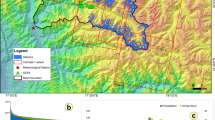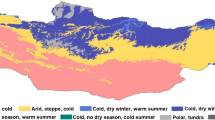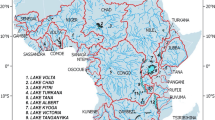Abstract
Wind controls the formation and development of sand dunes. Therefore, understanding the wind regimes is necessary in sand dune research. In this study, we combined the wind data from 2017 to 2019 at four meteorological stations (Cherigele and Wuertabulage stations in the lake basins, and Yikeri and Sumujilin stations on the top of sand dunes) in the hinterland of the Badain Jaran Desert in China, with high resolution Google Earth images to analyze the correlation between the wind energy environments and dune morphology. The results of data analysis indicated that both the wind direction and sand drift intensity exhibited notable spatial and temporal variations. The highest level of wind activity was observed in spring. Northwesterly and northeasterly winds were the dominant in the Badain Jaran Desert. At the Cherigele, Wuertabulage, and Yikeri stations, the drift potential (DP) was below 200.00 vector units (VU). The wind energy environments in most areas could be classified as low-energy environments. The resultant drift direction differed at different stations and in different seasons, but the overall direction was mainly the southeast. The resultant drift potential (RDP)/DP ratio was greater than 0.30 in most parts of the study area, suggesting that the wind regimes mainly exhibited unimodal or bimodal characteristics. Differences between the thermodynamic properties and the unique landscape settings of lakes and sand dunes could alter the local circulation and intensify the complexity of the wind regimes. The wind regimes were weaker in the lake basins than on the top of sand dunes. Transverse dunes were the most dominant types of sand dunes in the study area, and the wind regimes at most stations were consistent with sand dune types. Wind was thus the main dynamic factor affecting the formation of sand dunes in the Badain Jaran Desert BJD. The results of this study are important for understanding the relationship between the wind regimes and aeolian landforms of the dune field in the deserts.
Similar content being viewed by others
References
Al-Awadhi J M, Al-Helal A, Al-Enezi A. 2005. Sand drift potential in the desert of Kuwait. Journal of Arid Environments, 63(2): 425–438.
An Z S, Zhang K C, Qu J J, et al. 2014. The near-surface airflow filed of pyramid dune and its influence on the Crescent Moon Spring in Dunhuang, China. Journal of Desert Research, 34(1): 9–15. (in Chinese)
Bagnold R A. 1974. The Physics of Blown Sand and Desert Dunes. Dordrecht: Springer, 85–95.
Bai Y, Wang N A, Liao K T, et al. 2011. Geomorphological evolution revealed by aeolian sedimentary structure in Badain Jaran Desert on Alxa Plateau, Northwest China. Chinese Geographical Science, 21(3): 267–278.
Breed C S, Fryberger S G, Andrews S, et al. 1979. Regional studies of sand seas using landsat (ERTS) imagery. In: McKee E D. A Study of Global Sand Seas. Washington: United States Geological Survey, 305–397.
Bullard J E, Thomas D S G, Livingstone I, et al. 1996. Wind energy variations in the southwestern Kalahari Desert and implications for linear dune field activity. Earth Surface Processes and Landforms, 21(3): 263–278.
Chen F, Liu Y. 2011. Secular annual movement of sand dunes in Badain Jaran Desert based on geographic analyses of remotely sensed imagery. Remote Sensing Technology and Application, 26(4): 501–507. (in Chinese)
Chen J S, Li L, Wang J Y, et al. 2004. Groundwater maintains dune landscape. Nature, 432: 459–460.
Chen J S, Zhao X, Sheng X F, et al. 2006. Formation mechanisms of mega-dunes and lakes in the Badain Jaran Desert, Inner Mongolia. Chinese Science Bulletin, 51(24): 3026–3034.
Dong Z B, Wang T, Wang X M. 2004. Geomorphology of the megadunes in the Badain Jaran Desert. Geomorphology, 60(1): 191–203.
Dong Z B, Qian G Q, Luo W Y, et al. 2009. Geomorphological hierarchies for complex mega-dunes and their implications for mega-dune evolution in the Badain Jaran Desert. Geomorphology, 106(3–4): 180–185.
Dong Z B, Zhang Z C, Qian G Q, et al. 2013. Geomorphology of star dunes in the southern Kumtagh Desert, China: control factors and formation. Environmental Earth Sciences, 69(1): 267–277.
Fitzsimmons K E, Bowler J M, Rhodes E J, et al. 2007. Relationships between desert dunes during the late Quaternary in the Lake Frome region, Strzelecki Desert, Australia. Journal of Quaternary Science, 22(5): 549–558.
Fryberger S G, Dean G. 1979. Dune forms and wind regime. In: Mckee E D. A Study of Global Sand Seas. Washington: United States Geological Survey, 137–169.
Gao X, Narteau C, Rozier O, et al. 2015. Phase diagrams of dune shape and orientation depending on sand availability. Scientific Reports, 5: 14677, doi: https://doi.org/10.1038/srep14677.
Gao X M, Dong Z B, Duan Z H, et al. 2019. Wind regime for long-ridge yardangs in the Qaidam Basin, Northwest China. Journal of Arid Land, 11(5): 701–712.
Hereher, Mohamed E. 2014. Assessment of sand drift potential along the Nile Valley and Delta using climatic and satellite data. Applied Geography, 55: 39–47.
Lancaster N. 1994. Dune morphology and dynamics. In: Abrahams A D, Parsons A J. Geomorphology of Desert Environments. London: Chapman and Hall, 480.
Lancaster N. 1995. Geomorphology of Desert Dunes. London: Routledge, 1–7.
Lancaster N. 2013. Sand seas and dune fields. In: Shroder J F. Treatise on Geomorphology. San Diego: Academic Press, 11: 219–245.
Li G S, Li X Z, Qu J J. 2014. Investigating the interaction between Crescent Spring and groundwater in a Chinese dune-lake environment using hydraulic gradient and isotope analysis methods. The Holocene, 24(7): 798–804.
Li P, Tian J K. 2011. Characteristics of surface layer wind speed profiles over different underlying surfaces. Resources Science, 33(10): 2005–2010. (in Chinese)
Liu T, Yang X P, Dong J F, et al. 2010. A preliminary study of relation between megadune shape and wind regime in the Badain Jaran Desert. Journal of Desert Research, 30(6): 1285–1291. (in Chinese)
Lou T M. 1962. The formation and utilization of the desert between Minqing and Badain Monastery. In: Research of Desert Control, Series 3. Beijing: Science Press, 90–95. (in Chinese)
Ma N, Wang N A, Zhu J F, et al. 2011. Climate change around the Badain Jaran Desert in recent 50 years. Journal of Desert Research, 31(6): 1541–1547. (in Chinese)
McKee E D. 1979. Introduction to a study of global sand seas. In: McKee E D. A Study of Global Sand Seas. Washington DC: U.S. Geological Service, 1052: 3–19.
Ning K, Li Z L, Wang N A, et al. 2013. Spatial characteristics of grain size and its environmental implication in the Badain Jaran Desert. Journal of Desert Research, 33(3): 642–648. (in Chinese)
Niu Z M, Wang N A, Meng N, et al. 2021. Contribution of lake-dune patterning to the dune height of mega-dunes in the Badain Jaran sand sea, northern China. Remote Sensing, 13: 4915, doi: https://doi.org/10.3390/rs13234915.
Pang Y J, Wu B, Li Y H, et al. 2020. Morphological characteristics and dynamic changes of seif dunes in the eastern margin of the Kumtagh Desert, China. Journal of Arid Land, 12(5): 887–902.
Parteli E, Duran O, Tsoar H, et al. 2009. Dune formation under bimodal winds. Proceedings of the National Academy of Science, 106(52): 22085–22089.
Reffet E, Pont S C D, Hersen P, et al. 2010. Formation and stability of transverse and longitudinal sand dunes. Geology, 38(6): 491–494.
Rubin D M, Hunter R E. 1987. Bedform alignment in directionally varying flow. Science, 237(4812): 276–278.
Schatz V, Tsoar H, Edgett K S, et al. 2006. Evidence for indurated sand dunes in the Martian north polar region. Journal of Geophysical Research, 111: E04006, doi: https://doi.org/10.1029/2005JE002514.
Sun P, Sun Q. 1964. The hydrological geology of the western Inner Mongolia. In: Research of Desert Control, Series 6. Beijing: Science Press, 121–146. (in Chinese)
Thomas D S G. 1997. Sand seas and aeolian bedforms. In: Thomas D S G. Arid Zone Geomorphology. London: Belhaven Press, 373–412.
Tian M, Qian G Q, Yang Z L, et al. 2021. Characteristics of wind regime and its influences on the development of Aeolian landforms in the Haertenghe Reach, northeastern Qaidam Basin, China. Journal of Desert Research, 41(1): 1–9. (in Chinese)
Tsoar H, Parteli E J R. 2016. Bidirectional winds, barchan dune asymmetry and formation of seif dunes from barchans: a discussion. Environmental Earth Sciences, 75(18): 1–10.
Wahed M S M A, Mohamed E A, El-Sayed M I, et al. 2015. Hydrogeochemical processes controlling the water chemistry of a closed saline lake located in Sahara Desert: Lake Qarun, Egypt. Aquatic Geochemistry, 21(1): 31–57.
Wang K Q, Zhao H, Sheng Y W, et al. 2020. Distribution and morphological parameters of dunes in the Badain Jaran Desert based on DEM. Journal of Desert Research, 40(4): 81–94. (in Chinese)
Wang N A, Ma N, Chen H B, et al. 2013. A preliminary study of precipitation characteristics in the hinterland of Badain Jaran Desert. Advances in Water Science, 24(2): 153–160. (in Chinese)
Wang N A, Ning K, Li Z L, et al. 2016. Holocene high lake-levels and pan-lake period on Badain Jaran Desert. Science China Earth Sciences, 59(8): 1633–1641.
Wang T. 1990. Formation and evolution of Badain Jaran Sandy Desert, China. Journal of Desert Research, 10(1): 29–40. (in Chinese)
Wang X M, Dong Z B, Yan P, et al. 2005. Wind energy environments and dunefield activity in the Chinese deserts. Geomorphology, 65(1–2): 33–48.
Wang X M, Lang L L, Hua T, et al. 2015. Geochemical and magnetic characteristics of aeolian transported materials under different near-surface wind fields: An experimental study. Geomorphology, 239(15): 106–113.
Wang Z T, Chen T Y, Liu S W, et al. 2016. Aeolian origin of interdune lakes in the Badain Jaran Desert, China. Arabian Journal of Geosciences, 9(3): 190, doi: https://doi.org/10.1007/s12517-015-2062-6.
Wasson R J, Hyde R. 1983. Factors determining desert dune type. Nature, 304: 337–339.
Wen Q, Dong Z B. 2016. Geomorphologic patterns of dune networks in the Tengger Desert, China. Journal of Arid Land, 8(5): 660–669.
Wilson I G. 1973. Ergs. Sedimentary Geology, 10: 77–106.
Wu Z. 2003. Aeolian Geomorphology and Sand Engineering. Beijing: Science Press, 139–181.
Xiao J H, Qu J J, Yao Z Y, et al. 2015. Morphology and formation mechanism of sand shadow dunes on the Qinghai-Tibet Plateau. Journal of Arid Land, 7(1): 10–26.
Yan M C, Wang G Q, Li B S, et al. 2001. Formation and growth of high megadunes in Badain Jaran Desert. Acta Geographica Sinica, 56(1): 83–91. (in Chinese)
Yang J H, Xia D S, Wang S Y, et al. 2020. Near-surface wind environment in the Yarlung Zangbo River basin, southern Tibetan Plateau. Journal of Arid Land, 12(6): 917–936.
Yang X P. 2000. Landscape evolution and precipitation changes in the Badain Jaran Desert during the last 30 000 years. Chinese Science Bulletin, 45(11): 1042–1047.
Yang X P, Liu T S, Xiao H L. 2003. Evolution of megadunes and lakes in the Badain Jaran Desert, Inner Mongolia, China during the last 31,000 years. Quaternary International, 104(1): 99–112.
Zhang K C, Qu J J, An Z S. 2012. Characteristics of wind-blown sand and near-surface wind regime in the Tengger desert, China. Aeolian Research, 6: 83–88.
Zhang K C, Ao Y H, Qu J J, et al. 2013a. Dynamical environments of wind-blown sand near lakes surrounded by sand mountains in the Badain Jaran Dessert. Arid Land Geography, 36(5): 790–794. (in Chinese)
Zhang K C, Qu J J, Niu Q H, et al. 2013b. Characteristics of wind-blown sand in the region of the Crescent Moon Spring of Dunhuang, China. Environmental Earth Sciences, 70(7): 3107–3113.
Zhang K C, Ao Y H, Qu J J, et al. 2014. Influences of lake-sand dune landscape on local microclimate in Badain Jaran Desert. Bulletin of Soil and Water Conservation, 34(5): 104–108. (in Chinese)
Zhang K C, Cai D W, Ao Y H, et al. 2017. Local circulation maintains the coexistence of lake-dune pattern in the Badain Jaran Desert. Scientific Reports, 7: 40238, doi: https://doi.org/10.1038/srep40238.
Zhang W, Wang T. 2005. Approach to formation and evolution of mega-dunes in Badain Jaran Desert. Journal of Desert Research, 25(2): 281–286. (in Chinese)
Zhang Z C, Dong Z B, Li C X. 2015. Wind regime and sand transport in China’s Badain Jaran Desert. Aeolian Research, 17: 1–13.
Acknowledgements
This research was funded by the National Natural Science Foundation of China (41871021) and the Desert and Glacier Field Scientific Observation and Research Station of Lanzhou University (lzujbky-2021-sp16). We thank Prof. ZHANG Zhengcai and Prof. CHENG Hongyi for their helpful comments and suggestions.
Author information
Authors and Affiliations
Corresponding author
Rights and permissions
About this article
Cite this article
Meng, N., Wang, N., Zhao, L. et al. Wind regimes and associated sand dune types in the hinterland of the Badain Jaran Desert, China. J. Arid Land 14, 473–489 (2022). https://doi.org/10.1007/s40333-022-0063-3
Received:
Revised:
Accepted:
Published:
Issue Date:
DOI: https://doi.org/10.1007/s40333-022-0063-3




